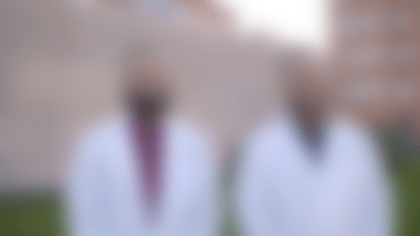The NFL hosted a virtual press call announcing the NFL Diversity in Sports Medicine Pipeline Initiative on May 24, 2022.
SPEAKERS:
- Dr. Allen Sills, NFL Chief Medical Officer
- Reggie Scott, Acting President, Professional Football Athletic Trainers; Vice President, Sports Medicine and Performance, Los Angeles Rams
- Dr. Tim McAdams, President, NFL Physicians Society; Head Team Physician, San Francisco 49ers
- Dr. Lisa Barkley, Family Medicine Department Chair at Charles R. Drew University of Medicine and Science
- Dr. Hugh E. Mighty, MD, MBA, Dean of the Howard University College of Medicine and Senior Vice President of Health Affairs
- Dr. Digna Forbes, Interim Dean of the School of Medicine, Meharry Medical College
- Dr. Herman Taylor, Director of the Cardiovascular Research Institute, Morehouse School of Medicine
- Dr. Anthony Casolaro, Chief Medical Officer, Internal Medicine, Washington Commanders
Dr. Allen Sills: Good afternoon or good morning, everybody, depending on where you're located. I'm super excited to be with you today. And I appreciate your interest in being here. I also want to say thanks to this very, very distinguished group that we have joining us. I want to pause and just say all of them are very busy people and for them to take time to be with us speaks to the commitment and the belief and the excitement that they share with me about this program. And so, I want to thank them for doing that and being part of this today. I think all of you know that the NFL is committed to increasing diversity across all aspects of our league and club operations, and that includes our medical staffs. Increasing diversity has been one of our league's top priorities, and it's a key focus of our owners and our league leadership. I mean, we're very intentional that diversity makes us stronger, and that's why it's one of our key priorities. And that focus on diversity really extends throughout the league's work, whether we're talking about the medical profession, to coaching, to business, to all aspects of our operations. So today we're here to talk about medical, and specifically, a new initiative called the NFL Diversity in Sports Medicine Pipeline. And I want to share with you for a moment what that is – but before I do, let me talk about why there's a need for that and why we feel that this is such an important initiative.
You know, there have been some studies recently that look at the fact that only about 7.3% of the entire medical student population are Black medical students today, and that figure has risen less than 1% over the last 40 years. So, there's definitely work to be done throughout medicine. This is not just an NFL issue, this is a challenge for all of us who are practicing physicians in all aspects of medicine. But if we zoom in on the NFL side of things, the NFL Physicians Society, the group that includes all of our team physicians, 86% of their members identify as white. If we look at the Professional Football Athletic Trainers Society, or PFATS, 65% of their membership identifies as white. So as organizations, as PFATS, as NFL Physicians Society, as the NFL, we've come together to say this is an issue that we want to address, that we want to be thought leaders in, and we want to put together programs that can constructively address the pipeline for making a change in the climate that we see today.
From that has come this pipeline initiative that we're going to talk about to you today. It's a partnership among the three of us and four HBCU medical schools who are represented today. The three on the NFL side, again, are the league, the NFL Physicians Society, the Professional Football Athletic Trainers Society. And so, we have partnered with, as you heard, the Charles R. Drew University School of Medicine and Science, the Howard University College of Medicine, the Morehouse School of Medicine and Meharry Medical College – four HBCU medical schools, to identify and select students who will do clinical rotations with an NFL club, with their sports medicine team, in order to expose them to Sports Medicine at the NFL level. We've chosen eight NFL clubs to host a total of 16 students from these HBCU schools. These will be one-month rotations in the months of September and October of 2022. So, it'll be during our competitive season so that the students will be exposed to the team in that part of the year. The eight clubs are the Atlanta Falcons, the Cincinnati Bengals, the LA Chargers, the LA Rams, the New York Giants, the San Francisco 49ers, the Tennessee Titans and the Washington Commanders. And again, each of them will host a total of two medical students. One who's interested in primary care sports medicine, one who's interested in orthopedic surgery, and we'll talk a little bit more during the call about what they'll do, but each student will be exposed to really all facets of the club's health and safety efforts, which is far more than just primary care or orthopedic surgery. That includes athletic training, strength and conditioning, performance, nutrition, behavioral health, rehab, physical therapy – all of these components make up the modern NFL sports medicine team.
We want the students to be exposed to that, to actually get immersed in that, to see that firsthand, to develop an understanding of what sports medicine today looks like. Students will have a chance to attend games as well for observation. And it's our hope that by the end of the rotation, the students will understand all of these facets of care that go into the care of the modern professional athlete from all of those different disciplines that I mentioned. So again, we're very excited about this initiative because we think this is how we begin to develop a pipeline of people who will not only become team physicians and sports medicine specialists in the NFL, but hopefully at other levels of play and involving other sports as well.
And we think that one of the best parts of this program is that with diverse medical staffs, we facilitate improved patient outcomes. I think that's been well-established in medical literature, and we are very committed to seeing our medical staffs become more diverse, again, in all these different areas that we mentioned. The program that we're talking about today, this Sports Medicine Pipeline Initiative, is just one initiative. I would not want anyone to think this is a one-year, one-time thing for this program. We hope to expand it next year to involve all of our clubs and also evolve additional schools and more students, because we expect that the interest will grow. But beyond that, we are looking at how we can diversify ourselves at all levels in the NFL medical community. Our NFL committees, our leadership groups, we're all working actively to bring more diverse members. They're working with our clubs when they do have vacancies as either physicians or athletic trainers to think about a diverse pool of candidates. We certainly have this pipeline program, and we anticipate that students will continue to be mentored as they move through their career. We've got some outreach to other HBCUs schools, those that don't have medical schools, to see how we can come alongside to help their sports medicine program and also get undergraduate students interested in some of the variety of careers that I mentioned before, which will lead them into being part of that sports medicine team.
So, there's a lot of work to be done. But today we want to focus on this Sports Medicine Pipeline Initiative and this medical student program, and we're very excited about that. So let me stop there and turn it over to my colleague Reggie Scott. As you heard, Reggie is president of the Professional Football Athletic Trainers Society and Vice President for Sports Medicine with, as he likes to say, "the Super Bowl winning" or "Super Bowl Champion" LA Rams. Reggie?
Reggie Scott: Thank you, Dr. Sills, I appreciate that and couldn't be more excited to work with the NFL on this. Jeff Miller and Dr. Allen Sills, definitely appreciate you so much. And working with the NFL Physicians Society, we've worked directly with Dr. Casolaro and Dr. McAdams leading the charge there, so we thank you so much.
From a PFATS perspective, that's the Professional Football Athletic Trainers Society, we're super excited to be a part of this initiative. This is truly dear to our hearts, as specifically with us, since 1993, We have adopted the PFATS ethnic minority scholarship, and in 2015 we did start a PFATS female scholarship, which is really an alignment of creating pipelines to bring exposure and awareness to athletic trainers. And I couldn't be more excited to be part of this program that really will bring a lot of exposure to the environment of elite athletes, pairing elite athletes with medical students from the HBCUs. Super excited also to work with all the various leaders and HBCU groups that we got to work with and we're super, super thankful for their time and efforts on this.
I think when you look at a pipeline approach to trying to create more diversity, as Dr. Sills says, will create better patient outcomes. I'm living proof of that, as I was a PFATS minority scholarship winner in 2001 – and so you can only imagine how full circle that is for me to be a part of this today, to understand that how I got my foot in the door as an athletic trainer in the NFL was through the PFATS minority scholarship. And that opportunity got me to this point. And so, I really do think that this is just the start to an awesome future with what this could be. Like Dr. Sills says, we've got a lot of work to do, and at PFATS, where we have developed the Diversity Council too, we're going to continue to look at different initiatives to bring awareness about the various subspecialties. You're talking registered dietitian, you're talking strength and conditioning, performance science and analytics, athletic training, behavioral health, even going down a road of looking in equipment managers. There are so many various jobs that affect our health and safety that we want to really continue to bring exposure to a lot of diverse people, to hopefully create a little spark in them so that one day they want to get into this field. So, thank you very much Dr. Sills, and I'm going to pass it off to Dr. McAdams now from the NFL Physicians Society. Thank you.
Dr. Tim McAdams: Thanks, Reggie. Greetings everyone. As president of the NFL Physicians Society, I'm representing the 180 physicians that take care of the players from each of the 32 clubs, and our mission is really to provide excellence in both the medical and surgical care of these athletes, but also to provide some support for the Athletic Training Society as well when they're working day-in, day-out with the players in terms of what the month rotation would be when they're working with the team physician for each of these medical students.
It starts with the basic core curriculum of knowledge basic on sports medicine from head to toe, the anatomy, the physical examination, image analysis, but it goes well beyond that. And that's what's really exciting about this is it really is a complete total immersion into what is life like as a team physician in the NFL. Not only will they spend time with the team physicians in their offices, and sometimes in their operating rooms, but they'll also spend time in the athletic training room working with the team physicians and the athletic trainers looking at return-to-play guidelines. They'll spend time out on the practice field while they're getting exposure to the management of on-field injuries. And, as Reggie alluded to, the model for sports medicine has now involved a lot of different disciplines and they will get exposure to these – to spend a day with the nutrition group, a day with strength conditioning, physical therapy modalities, and even the performance metrics team. So, through this, they will not only gain exposure to what life is like as a team physician, but also develop relationships with each of these different disciplines.
Mentorship is a critical component of our ability to recruit medical students into our field. And so on behalf of myself and Dr. Casolaro, the NFL Physicians Society, we're very excited about getting this started this fall and just excited to see this expand and blossom in years to come. I'll now I'll turn this over to Lisa Barkley, who's the Chair of Family Medicine at the Charles R. Drew University of Medicine and Science.
Dr. Lisa Barkley: Thank you. It's such a pleasure to be here today. One of my specialties in family medicine is primary care sports medicine, and when I trained in sports medicine over 20 years ago, when you would go to the meetings there was probably a handful of people who were Black and maybe two handfuls of women at the meetings. And I'm so happy to see that we are now creating a very structured pipeline to help to improve those numbers. They certainly have improved over the years, but we certainly have a way to go.
I know from my experience practicing medicine, as well as teaching doctors to be doctors, that it's very important to understand the social context where your patients are coming from. We know from research that over 80% of the things that impact our health are what happens in our social environments, our health behaviors, etc. – only 20% comes from medical care. So having sports medicine providers who look like the patients, the athletes that they're serving, who can relate and talk about some of the impacts of social factors on overall health is really going to help to improve the overall health and well-being of our athletes. And the NFL is showing that they're dedicated to that by putting the resources into this type of pipeline.
The other component is just as important from the provider side. It's important to see other providers who look like you and having that exposure is very important in this field of sports medicine, because a lot of it is the opportunity that you have to cover a team or to be exposed to sports. So, providing our medical students with this early on in their career is really going to be career-changing for them. And it will really help build a pipeline. I've noticed just by me being a sports medicine specialist in our training program, we have five residents who want to go into sports medicine right now – and that will continue to grow through this partnership. So, I'm very thankful for this. I look forward to all the good things that are going to come from it. I will turn it over to Dr. Mighty from the Howard University College of Medicine.
Dr. Hugh E. Mighty: Thank you, Dr. Barkley. Good afternoon and thank you everyone. Thank you, especially, to the NFL for this opportunity. Pipelines, mentorship are the business that actually ends up growing a base for a specialty. And I think that although we start today with the NFL, I'm already looking ahead.
Sports are a big part of the fabric of America at all levels. And many times, you know, getting proper sports support leads itself to being in professional teams. But I see the need for this across the board. We see high school sports becoming much more sophisticated. The number of sports that we have women participate in, it continues to grow. And so, to be able to support that eventually, I think would be the real goal of this program. To create pipelines that continue to grow, especially to give opportunity to our minority students. And later on, also I have to put in a plug, that we have physical therapists as well and nutritionists who are going to be chomping at the bit to be a part of this. Many of our athletes started in the neighborhoods where some of our students come from. And so now, they get to relate not only to seeing success, but also being a part of that picture and understanding what goes into that. I think it's going to be a two-way exchange not just from the students having an opportunity to learn, but also from the athletes being able to look back and remember you know, part of their beginnings and seeing minorities come through. So I think this is an exciting program. Howard is excited to be a part of this program. And thanks again to the NFL, who brought this program to us, so appreciate it. I will turn it over to Dr. Digna Forbes from Meharry, to pick up our dialogue.
Dr. Digna Forbes: Hello. Today we are excited to see the beginning of this bold and innovative collaboration with the NFL, the NFL Physicians Society and the Professional Football Athletic Trainers Society. The NFL's commitment to increasing diversity across all areas of the league directly aligns with the vision set forth by Meharry's President and CEO Dr. James E.K. Hildreth. As part of our 2026 strategic plan, Meharry Medical College is working to increase the number of diverse healthcare professionals around the nation. We are working on creating a pipeline for more minorities and people of color to have careers in medicine.
While Meharry is known for our focus on producing primary care physicians, it is equally important for us to help increase diversity among medical specialties, which in too many instances, minorities are overwhelmingly underrepresented. Only 4 in about 106 students in the School of Medicine, class of 2022 matched in sports medicine and related specialties. We hope this unique and exciting collaboration will excite our students and open new opportunities for them to gain entry into highly competitive medical specialty areas such as sports medicine and orthopedics. Our overall goal is to expand our sports medicine fellowship by increasing the number of residents in the program. Nationwide, there is a critical need for a pipeline of African Americans and diverse talent within medicine. Now more than ever, minority communities need greater access to culturally competent health care. This new partnership with the NFL is one of several Meharry has entered into in the last few years as we strive to diversify the nation's healthcare workforce, as we work toward our mission of worship of God through service to mankind
I believe I can speak for all of Meharry's leadership when I say we are truly excited to be part of this unique and historic partnership between the NFL and HBCU medical schools. It is just the right catalyst needed to spark true change needed for diversity among the NFL medical staff to reflect the diversity represented among the NFL players, the fans and supporters. Thank you and I now turn it over to Dr. Taylor from Morehouse School of Medicine.
Dr. Herman Taylor: Thank you so much, Dr. Forbes. And I'd like to join my colleagues from the other three historically Black medical centers in the United States in saying that we recognize that this is a tremendous first step towards increasing diversity among the ranks of the people who care for the elite athletes of the National Football League. We recognize that there is a long way to go, presently, that the numbers are small for people of color in taking care of what is essentially a league of color. That I think is an important recognition on the part of PFATS, the part of the National Football League Physicians Society, as well as the league itself to step forward and embrace the research that says that you often get outstanding results when you increase the number of people of color caring for people of color as well as non-minority patients. This type of diversity is demanded by the research is consistent with best practices and it produces the best results.
At Morehouse School of Medicine, our motto is "leading the creation and advancement of health equity." We've been recognized, repeatedly, alongside our great brother and sister institutions, as being focused on dealing with the issues of disparities. Some of our research that we're conducting has suggested that the disparities we see between Blacks and other groups the United States that exist in society at large, also seem to seem to carry through in the experience of the National Football League. That is a sobering message that we need to do more. While we have the players in their active years, we need to give them the best care possible and set them up for lives beyond football that are healthy. I'd like to also echo what Dr. Mighty said in terms of this hopefully being a model to other leagues, to other people who are in charge of the health of these very special athletes, male and female, going forward. And I'd like to congratulate the League, and the Society, and PFATS on coming together to take this step forward, a bold step forward, and model for athletics all around. Thank you.
QUESTION: For the medical school representatives on the call, what can this initiative do for the chosen medical students' future careers? Dr. Barkley, I'll toss it over to you to start and then certainly anybody who might like to chime in thereafter, please feel free
Barkley: Thank you. That's a great question. It's going to be very important for their careers. You have to do a lot to qualify to train in a sports medicine fellowship. You have to train in a fellowship in order to practice sports medicine. So, this will give students the exposure to gain coverage, the exposure to learn how to do the physical exams, and the assessments, the return-to-play – all the different facets that happen in the sports medicine arena. Because you're going to need to know that to be qualified to enter a training program.
Forbes: It is extremely competitive to get a residency program. And so, the students go through the match, and with this, this is more or less a specialized area, something that they can add to their CV, and it will make them more competitive when they apply for sports medicine and orthopedics.
Taylor: I think exposure is so critical to making these life and career decisions. I mean, I'm a cardiologist today because of some early exposures I had to cardiology. It captured my imagination, and it allowed me to see that I could do this. Giving students this experience early in their career development, I think is critical. For some, this may convince them of something they already were terribly interested in, or it may open the eyes of others to the possibilities. So, I think it's a great step for them.
QUESTION: How did you all choose the HBCUs and the NFL clubs that that will take part in this program for this first season? How did this come together? Maybe you could tell us a little bit about the origins of it.
Dr. Anthony Casolaro: Sure. It began with a conversation with Dr. Sills almost two years ago about trying to broaden the diversity. My first conversation was with Michael Crawford and Dr. Hugh E. Mighty more than a year and a half ago, and it kind of just grew from there. We thought that would be the best approach to begin, I think as Dr. Sills said, we hope this expands – and we expect it will expand to other schools – and there are four medical HBCU schools. So that was a natural starting point.
All the folks on this call have been involved with the planning over the last year or so. So, in terms of the students, we've asked that each of the schools identify the students that will participate. I might add, we were talking about how might this affect their careers. All of us in medicine pick what we're doing based on role models, and our exposures. And these young men and women who do these rotations will have exposure to really the best sports medicine specialists in the in the country and in the world. And terrific role models like Tim McAdams or Chris Annunziata, these are people they'll get to work with on a regular basis. And as they move on in their career, they'll have those contacts to help guide them, which I think is really important as was mentioned before – mentoring is critical.
Sills: To the part of the question about how we chose the eight teams – there was just tremendous interest. There was a lot of interest across the league, but we wanted to keep this small in year one and you know, as we said make sure that we did a quality job and assess how we can improve this going forward. So, there was some preference around geography, obviously, you'll notice around where schools are, but there was tremendous interest from a number of clubs across the NFL and as you mentioned, we hope to expand it to all our clubs next year.
QUESTION: We've got a couple of similar questions for the medical school representatives on the call about how you'll select the students who will participate in this program. I know that each school has slightly different criteria. You all are setting criteria yourself and doing that selection yourself. But I wonder if anybody would like to jump in on this. Maybe Dr. Mighty, would come over to you first, and talk about how are you all at Howard are selecting the students who will participate in the program? In what year, if there's any specificity around that, when the students be in participating?
Mighty: So, in many ways, the students are going to self-select – they're not going to be shy. If you have an interest in orthopedic surgery, it's kind of a special breed. There are certain specialties where the kids come along, and they know this is kind of what they want their career to be. All we have done here is amp that up by saying "Well, would you like to spend some time working with an NFL team?" We're not going to have any shortage of people who vie for the position. At the end of the day, we will go through our chairman of departments, and Deans of Students, who are much closer aligned with the students and our Deans of Students, who know the students best because obviously, it's going to get tough.
I think we will obviously get more than two students who want to do this between our family medicine and orthopedic surgery department. It'll be a tough call, but the enthusiasm will be extremely high. So, if anything, we're going have the problem of, you know, keeping some people back until we expand the program – which hopefully again will be quicker, you know, sooner rather than later because we will have candidates for sure.
QUESTION: For the NFL representatives on the call, could we talk about the universe of opportunity in the field – as in how many sports medicine professionals does the NFL need overall? And how much do Sports Docs and surgeons typically get paid? I wonder if Dr. Sills if you want to kick that off. And then certainly if Dr. McAdams and Reggie you want to weigh in as well.
Sills: I'm happy to report on Dr. McAdams' paycheck, I'm sure he won't mind me saying that. You know, I think there's an enormous need, because again, as we talked about, first of all, there's tight supply in terms of the people who get into residency. You know, you heard already that these are competitive fields. But sports medicine continues to expand, because as was mentioned in earlier remarks, the expectations at other levels beyond the professional game continue to expand. So, at the collegiate level, at the high school level, at the community level, you know, sports medicine is way bigger than what we're just talking about here at the NFL. We have needs at all of those levels of play, if you will, and also in many different disciplines.
As you've also heard, sports medicine is no longer just primary care or orthopedics. Now it involves a whole panel of specialists – from behavioral health, to nutrition, to performance, to equipment, to strength and conditioning. So, I think there's a vast need that's out there. And I think that it's about helping people understand how many different career paths there are. It wasn't that long ago, where if you thought of yourself as "I want a career in sports medicine," you had to become an orthopedic surgeon. That was just kind of the one path that you did. And I think part of the point of this program, and the education and the information we'll share, it's to say there are a lot of different roads that now lead into sports medicine, that that previously just weren't open. And so, we want to make sure that we promote and attract candidates, and certainly diverse candidates, into all of those fields as well.
McAdams: And I would just add that we've heard about the importance of diversity, and how that can actually – in medicine, that leads to improved patient outcomes. We have a lot of work to do. You know, NFL Physicians' Society, we have 5% of Black members. This mirrors what we have going on in orthopedics nationwide. And, about 2% of nationwide practicing orthopedic surgeons are Black. And so, we have a lot of work to do, but through this type of pipeline process, we have a proven track record that these things can work. We're seeing increases in orthopedic percentages of Black applicants as well as current residents, so it does work. Getting back to the mentorships, what I pointed out – some of the experience of working in this type of fellowship is someone takes you under their wing, and you can see yourself being that type of practice when you get done. So, generating that excitement is what it's all about. And that change has to start within.











